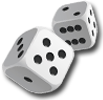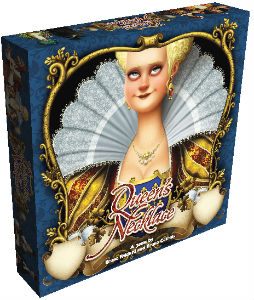



play board games
Board game reviews, strategy tips & session reports
Queen’s Necklace Review
 Stats:
Stats:
No. of players: 2-4
Amount of time to play: 30-45 min
Age requirements: 8+
Set-up time: 5 min
Queen’s Necklace is a card game in which you take on the role of a jeweler in Paris before the French Revolution. You want to buy gems that are in fashion for as little as possible and make a big profit when it comes time to sell. The person with the most pounds wins the game.
Queen’s Necklace Rules Description:
The 4 gem tiles (Diamonds, Emeralds, Amber and Rubies) are shuffled and placed to show which of the fours gems is currently most in fashion, which the second most popular and so on. The 3 Merchant cards (which signal it is time to have a sell) are inserted in the deck, one at approximately 1/3 of the deck, one at 2/3 of the deck and the last within the bottom 5 cards. You then place the top 5 cards on the board and put a translucent disc on the upper right number of each card. This number is the cost of the card.
Each turn consists of 3 phases: Influence, Card Purchase, and Devaluation. During the Influence Phase you may play any Influence Character card currently in your hand. These cards have blue titles and can help you by letting you look at other people’s hands, change the most popular gem type, steal cards from other players, and more. You may play as many Influence Character cards from your hand as you wish.
Next you will purchase the cards that you put in the center of the table. You must purchase at least one card. Each turn you get 10 pounds to spend and leftover pounds do not rollover to the next turn. The purchase price of each card is the number under the translucent disc. You will need to determine what cards you want versus what cards you want to keep other players from getting. You should also try to keep track of what other players are buying. This will help you when it comes time to sell your jewels.
You’ll notice each card has more than one price that is because at the end of your turn you devalue all the cards that you didn’t purchase. So on the first player’s turn everything will cost the maximum price. Any cards they did not purchase will move down in cost by one number and new cards will be added at maximum price to fill in the spots left by what the first player bought. If a card gets to the bottom symbol it is discarded and replaced with a new card that starts at maximum price.
Play continues to the right until someone draws one of the Merchant cards you inserted into the deck at the beginning of the game. You now have a Jewel Sale, after the third sale the game ends. There are three steps to a Jewel Sale displaying the jewels, determining rarity and selling the jewels. Cards labeled sell and any gems may be displayed. You secretly decide which gems you want to sell. You don’t even have to sell anything. If you are able to remember what the other players bought it may help you determine what you have the best chance of selling, but sometimes people don’t sell what you think. Once all players have decided on what they are selling everyone places the cards they want to display face up at the same time. To determine the rarity of the gems you count the total number of gems displayed by all the players. You then take the Rarity tiles and place the 1st/+3 tile under the rarest gem (the gem displayed the least). The 2nd/+2 is placed under the next rarest gem and so on. Ties in rarity go to the most popular gem being the rarest. The player with the most gems of one gem type on display completes the sale. Ties are not broken for sales. This means only 4 sales (not accounting for ties) will be completed. Your jewels will sell for anywhere between 0 and 6 pounds. You get the total pounds by combining the Popularity tile with the Rarity tile. Rings act as multipliers and can greatly increase the value of a sell. At the conclusion of the Jewel Sale, all cards on display are discarded whether they were sold or not and the rarity tiles are set aside for the next sale. Each player’s pounds are recorded on the scoring track and play resumes where it left off. Unless it is the third sale at which point the game ends and the player with the highest score wins.
A Quick Review of Queen’s Necklace:
Queen’s Necklace is a game that seems more complex when you are reading the rules then when you actually play it. Once you play, it is a lot less intimidating. This game mixes enough strategy with interaction and luck to be fun for most anyone.
The components for the second edition are well done. I know some people are not wild about the art. I think it looks fine and it is nice this edition has a board. The rules are easy to read and follow and have been updated to be clearer and include FAQs from the original game.
I didn’t get into a lot of details about the different character cards and their roles, but they help make the game exciting and add some interaction to the game. Some characters are loaded with ‘take that’ so be aware if you have a sensitive group.
I also like how the supply and demand see-saw in this game. You want to win a sell by bringing the most of one gem type. But the greater number of that gem in the sell devalues its rarity.
Like I mention in the description remembering what other people have bought (or playing a Confessor right before you think a Merchant will come up) can help you better guess what people will sell. I have also found Rings can be very helpful and score you lots of points.
The biggest problem with Queen’s Necklace is that it can be hard to win once you have fallen behind. Thankfully everyone can gang up on the leader, but I know not everyone enjoys that.
If you are looking for a fun light card game and your group doesn’t mind Queen’s Necklace’s direct interaction, you should pick it up.
Score and synopsis: (Click here for an explanation of these review categories.)
Strategy 4 out of 6
Luck 4 out of 6
Player Interaction 6 out of 6
Replay Value 4 out of 6
Complexity 3 out of 6
Fun 5 out of 6
Overall 4 out of 6


Leave a Reply